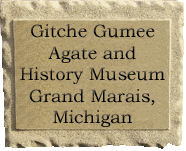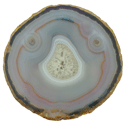MINERAL OF THE MONTH
November 2013 - Skip-an-Atom Agate

Although controversial, some people classify Skip-an-Atom Agates as s a sub-variety of Lake Superior Agate. These rocks are usually opaque with patterns of large quartz crystals with evenly distributed tiny air spaces that sometimes manifest with a lilac color cast.
These Lake Superior nodules are usually found in and around Duluth, MN – and are quite rare. In cases when these nodules were moved by glaciers or icebergs, they can also be found elsewhere including on the beaches of Grand Marais.
During the last few years rockhounds around the Mid-west have discussed these silica nodules. It seems that there is not agreement on several fronts. People do not agree on whether these specimens are in fact agate. They do not agree on exactly what constitutes a Skip-an-Atom Agate or how you can determine whether you have found one. Most agree that these specimens have a quartz ball center with a weird macro-quartz pattern. It does seem that the crystalline structure within these specimens was chemically or thermally altered causing the silica to recrystallize.
Apparently these agates were named by an elderly rockhound who thought the quartz looked so unusual that it must have "skipped an atom" in its formation. Thus, this is a descriptive term and does not have any scientific validity.
Many Skip-an-Atom agates are characterized by their notched and indented quartz crystals. The pattern of quartz crystals in Skip-an-Atom agates have been described as crenelated – like the indented/notched battlement top of the walls on an old fort (as shown below).
There are many theories about how these specimens formed. Some feel that these rocks formed due to the heat and pressure of a meteoric impact since the crystalline pattern resembles the shocked quartz found at impact sites (sample shown below).
Another hypothesis is that these “agates” are metamorphosed silica-rich schist called sericite. Schist is a type of metamorphic rock that is chiefly comprised of flaky minerals and exhibits a plated structure. A quartz sericite is shown below.
Typically schists contain significantly lower levels of quartz, but quartz-sericite schist is a variety that does contain more silica. As its name implies, this type of schist also contains significant amounts of sericite, which is a fine-grained type of either muscovite or paragonite, both of which are relatively abundant silicate minerals. Found in various locations, one of the best known examples of quartz-sericite schist occurs in Canada, where it is a source of economically important gold deposits.
A more plausible explanation is that contact metamorphism formed these rocks when hot molten lava intruded preexisting agate bearing rock causing the transformation of the silica in the agate nodules that were still resident in the vesicle pockets.
Here are some more photos of a Skip-an-Agate found by local resident, Kim, in Grand Marais, Michigan.
CITES:
- Yellow Cat
- Martin Schmieder
- Robert Lavinsky
Mineral of the Month Archives
May 2007: Rainbow Fluorite
June 2007: Lake Superior Michipicoten Agate
July 2007: Labadorite
August 2007: Rain Flower Agate
Fall 2007: Malachite
December 2007: Nepheline Syenite
January 2008: Native Copper
February 2008: Amazonite
March 2008: Lake Superior Agate
April 2008: Shadow Agate
May 2008: Apohpylite
June 2008: Ocean Jasper
Summer 2008: Marra Mamba Tiger's Eye
September 2008: Mohawkite
October 2008: Mexican opal
November 2008: Prehnite
December 2008: Picture Jasper
January 2009: Sea Shell Jasper
February 2009: Polychrome Jasper
March 2009: Selenite Desert Rose
Spring 2009: Coyamito Agate
July 2009: Obsidian Needles
August 2009: Goethite
September 2009: Banded Iron Formation
Fall 2009: Fairburn Agate
March 2010: Fossilized Dinosaur Bone
April/May: 2010 Kentucky Agate
June 2010: Nantan Meteorite
July 2010: Mookaite Jasper
Aug/Sept 2010: Polyhedroid Agate
Fall 2010: Ammonite Fossil
September 2011: Petoskey Stones
Spring 2011: Petrfied Wood
Winter 2011: Argentina Condor Agate
January 2012: Mary Ellen Jasper
March 2012: Mexican Crazy Lace Agate
June 2012: Moqui Marbles
September 2012: Chlorastrolite Greenstone
March 2013: Jacobsville Sandstone
August 2013: Unakite
November 2013: Skip-an-Atom Agate
April 2014: Tiger's Eye
September 2014: Black Corundum
February 2015: Condor Agate
June 2015: Petoskey Stone
November 2015: Slag
June 2016: Lake Superior Copper Replacement Agates
March 2017: Chert
July 2017: Kona Dolomite
December 2017: Septarian Nodule
Copyright All rights reserved.
Gitche Gumee Museum.
E21739 Brazel Street
Grand Marais, Michigan 49839















